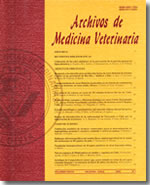Improvements in stunning of cattle with a pneumatic stunner after changes in equipment and employee training
Main Article Content
Abstract
Observations in chilean slaughter plants indicated that stunning of cattle to render them insensible prior to slaughter needs to be improved. The aim of this study was to quantify possible improvements by changes in equipment and training of employees.
During the commercial stunning process, data from a total of 1335 cattle were registered in a beef slaughter plant. Three hundred and thirty five cattle were scored to obtain baseline data before improvements were made on both equipment and employee training; a stunning box without head restraint and a pneumatic stunner powered by the same air compressor that ran all of the pneumatic equipment on the cattle slaughter floor were used. A second group of 500 cattle were scored after a new stunning box with a head holder to position the animals head was installed and a separate air compressor was purchased to power the pneumatic stunner. A third group of 500 cattle were scored after employees were trained in cattle behaviour principles to improve stunning and handling.
Each animal was scored in terms of the number of shots required to induce insensibility, the presence of sensibility signs after shooting (rythmical breathing, vocalization, corneal reflex and eye movement, attempt to stand up or head elevation), and the stun to stick time. A chi square analysis was used to determine statistically significant differences (p<0.05) between baseline data and new equipment installation and between the latter and employee training.
Baseline data showed that only 72.8% of the cattle collapsed instantly after one shot and 27.2% required 2 or more shots. Vocalization (moos or bellows) occurred in 46.9% of the cattle after stunning and 66.9% of the cattle had corneal reflexes. After installing the new equipment, the percentage of cattle that instantly collapsed after one shot improved to 89.6% and only 10.4% required 2 or more shots. Vocalization and corneal reflexes occurred in only 2.2% and 0.8% of the cattle, respectively. Training employees about stunner positioning and checking sensibility signs brought about further improvements with 97.8% rendered insensible with one shot, 0% vocalized and corneal reflexes occurred in 0.2%. To reduce the possibility of a stunned animal regaining sensibility prompt bleeding is recommended. Before employee training only 28.2% of the cattle were bled before 2 minutes and after training, almost all animals (99.8%) were bled within 2 minutes.
It can be concluded that proper equipment as well as employee training increased significantly the efficiency of the pneumatic captive bolt stunning process in cattle.

